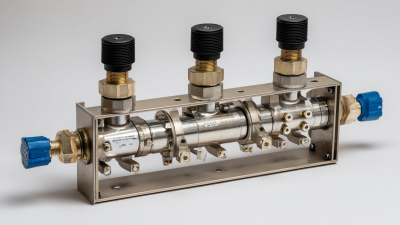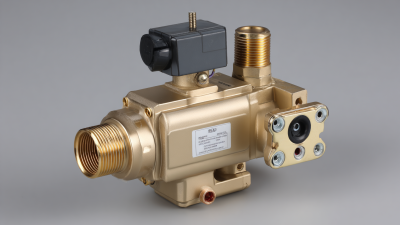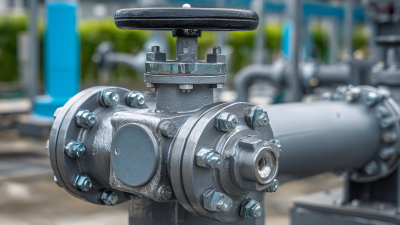Understanding the Purpose and Functionality of Flow Control Valves
In the intricate world of fluid mechanics, the flow control valve plays a crucial role in managing the movement and distribution of liquids or gases within a system. Understanding the purpose and functionality of flow control valves is essential for engineers and technicians who work to ensure optimal performance in various applications, from industrial processes to residential plumbing. These valves are designed to regulate the flow rate, maintain system pressure, and enhance operational efficiency, thus preventing potential damage or failures in pipelines. By delineating the various types of flow control valves, their mechanisms, and areas of application, this blog aims to provide a comprehensive overview that not only highlights their significance but also assists readers in making informed decisions regarding their use and maintenance in different engineering contexts.

Overview of Flow Control Valves and Their Importance in Fluid Systems
 Flow control valves play a crucial role in maintaining the stability and efficiency of fluid systems across various industries, including oil and gas, water treatment, and manufacturing. According to a recent market research report, the global flow control valves market is projected to reach approximately $15 billion by 2025, driven by the increasing demand for precise fluid management. These valves help regulate the flow, pressure, and direction of fluid, which is essential for ensuring the proper functioning of various processes. Their ability to minimize fluid loss and maintain desired flow rates not only enhances operational efficiency but also contributes to sustainability efforts by reducing energy waste.
Flow control valves play a crucial role in maintaining the stability and efficiency of fluid systems across various industries, including oil and gas, water treatment, and manufacturing. According to a recent market research report, the global flow control valves market is projected to reach approximately $15 billion by 2025, driven by the increasing demand for precise fluid management. These valves help regulate the flow, pressure, and direction of fluid, which is essential for ensuring the proper functioning of various processes. Their ability to minimize fluid loss and maintain desired flow rates not only enhances operational efficiency but also contributes to sustainability efforts by reducing energy waste.
To effectively use flow control valves, it’s advisable to consider the specific requirements of your fluid system. One tip is to regularly assess the flow conditions, since flow rates can vary due to temperature and viscosity changes. Another important aspect is to choose the appropriate valve type for your application. For example, globe valves are ideal for throttling applications, while ball valves are more suitable for on/off control. Ensuring that the flow control valve is appropriately sized and maintained can significantly improve reliability and performance.
Regular maintenance and testing are essential to prevent failure in fluid systems. It’s recommended to establish a routine inspection protocol for flow control valves, looking for signs of wear or leaks. Implementing predictive maintenance strategies, powered by data analytics, can also enhance valve performance by addressing potential issues before they lead to costly downtime. By prioritizing these practices, industries can ensure that fluid systems operate at peak efficiency.
Types of Flow Control Valves: An In-Depth Look at Their Specific Applications
Flow control valves are essential components in fluid systems, allowing for the regulation of flow rates and pressure. Understanding the various types of flow control valves can significantly impact their application in different industries. One common type is the needle valve, which offers precise control over fluid flow by using a tapered point. This makes it ideal for applications that require fine adjustments, such as in laboratories or hydraulic systems.
Another important category is the orifice flow control valve, which uses a plate with a specific-sized hole to restrict flow. This design is particularly effective for managing flow in large piping systems, where consistent flow rates are necessary to maintain system efficiency. Additionally, servo-controlled valves offer automated flow control based on feedback from the system, making them suitable for complex industrial processes where real-time adjustments are pivotal.
Each type of flow control valve is designed with specific functionalities, allowing engineers to select the best option for their unique applications.
Key Features and Design Considerations for Effective Flow Control
Flow control valves are critical components in various engineering applications, particularly in fluid power systems, where they regulate the flow and pressure of fluids to ensure optimal performance. When designing these valves, it is essential to consider several key features. First, the valve's response time and adjustment accuracy greatly influence performance, especially in dynamic environments where quick changes in flow are required. Advanced sensor technologies can be integrated into the hydraulic systems to monitor performance in real-time, providing feedback that enhances control efficacy.
In addition to responsiveness, the design of flow control valves must take into account the specific application requirements, such as fluid properties and operating conditions. For example, in applications involving turbulent flow scenarios, such as in dry powder inhalers, the implications of swirling flow must be analyzed to improve pulmonary delivery. Moreover, utilizing passive flow control methods can enhance aerodynamic efficiency in systems like nozzles. By understanding these design considerations and features, engineers can create effective flow control valves that meet the demands of modern applications, whether in industrial settings, transportation, or robotics.
How Flow Control Valves Enhance Efficiency and Safety in Industrial Processes
Flow control valves play a critical role in enhancing both efficiency and safety across various industrial processes. By regulating the flow rate of liquids and gases, these valves ensure optimal performance of systems, leading to significant energy savings. According to a report by the U.S. Department of Energy, optimizing flow systems can reduce energy consumption by up to 30%, which translates to substantial cost savings for manufacturers. This efficiency not only lowers operating costs but also contributes to a more sustainable industrial environment.
In addition to energy savings, flow control valves are essential for maintaining safe operational parameters. For instance, the chemical processing industry relies heavily on precise flow management to avoid hazardous situations. A study conducted by the National Fire Protection Association found that improper flow control can lead to catastrophic accidents, underscoring the importance of using high-quality valves that are designed to withstand extreme conditions. By implementing advanced flow control technologies, industries can significantly mitigate risks and enhance overall safety. This dual benefit of efficiency and safety makes flow control valves indispensable in modern industrial applications.

Common Issues and Troubleshooting Tips for Flow Control Valve Performance
Flow control valves are essential in various industrial applications, regulating the flow of fluids to maintain optimal performance and prevent equipment damage. However, common issues can arise that affect their functionality. A report by the International Journal of Engineering Research highlights that nearly 30% of flow control valve failures stem from improper installation or maintenance, leading to system inefficiencies and increased operational costs.
One of the prevalent problems is valve stickiness, often caused by contaminants accumulating in the valve mechanism. Research from the American Society of Mechanical Engineers indicates that regular inspection and maintenance can increase valve lifespan by up to 50%. Implementing a proactive maintenance schedule, including flushing the system and replacing seals, is crucial to mitigating these risks. Additionally, monitoring pressure drops across the valve can help identify obstructions or wear early on, allowing for timely interventions and ensuring consistent performance.
Another issue is improper sizing of the valve, which can lead to cavitation or excessive noise. According to a study conducted by the Fluid Control Institute, using the correct sizing guidelines can improve efficiency by 20% and significantly reduce energy consumption. Therefore, careful consideration during the selection process is vital for maintaining flow control valve performance and reliability in operational systems.
Understanding the Purpose and Functionality of Flow Control Valves - Common Issues and Troubleshooting Tips for Flow Control Valve Performance
| Dimension | Details |
|---|---|
| Purpose | Regulate the flow rate of fluid in a system. |
| Functionality | Control the speed and pressure of fluid within pipes. |
| Common Issues | Leakage, blockage, incorrect pressure readings. |
| Troubleshooting Tips | Inspect seals, check for debris, verify pressure gauge accuracy. |
| Maintenance Frequency | Every 6 months or as per system requirements. |
| Application Areas | Hydraulic systems, water distribution, industrial processing. |
Related Posts
-

Top Strategies for Enhancing Efficiency with Pneumatic Valves in Industrial Applications
-

Innovative Technologies Shaping the Future of Best Pneumatic Ball Valve Solutions and Strategies for Global Procurement
-

7 Effective Strategies for Choosing the Right Electric Valve
-

Unlocking Efficiency: Technical Specifications of the Best 3 Way Ball Valve and How to Optimize Its Use
-

Discover Top Quality Electric Valves from Leading Manufacturers in China
-

Embracing Innovation in the Future of Best Motorized Valve Technology
